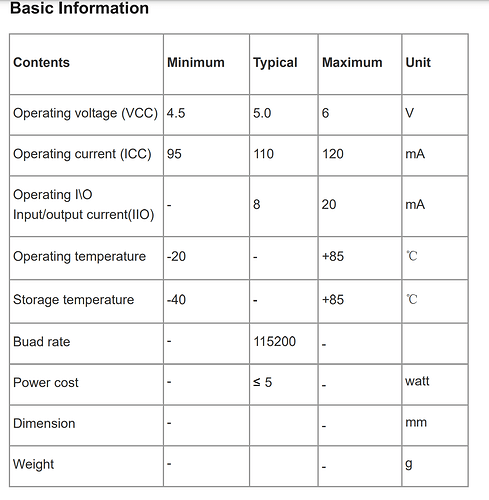Hi,
I was looking to battery power the mmWave Human Detection Sensor, but did not find any information about the power consumption of the mmWave sensor.
The XIAO ESP32c3 should be very resourceful, but I don’t know if it is possible to rely on battery power with the mmWave sensor.
Are there real world messurements of the average power consumption in a household? For example, in a hallway, or kitchen, bedroom etc.
Help would be appreciated.
Best Fabian
“Be careful that the power input does not exceed 5V/1A, otherwise the product may be damaged”.
This is the only info regarding the power here: mmWave Human Detection Sensor Kit | Seeed Studio Wiki
This does not answer my question, sorry If I have not made my question clear enough, and you therefor might have misunderstood.
My question is:
What is the average power consumption [watt per hour] in a “normal” environment like a hallway, kitchen or similar rooms where this sensor would be useful to turn on the light when human presence is detected. I assume for a storage room it would be ~1–5 times a day, for a kitchen maybe ~10-50.
Is it therefore a viable option to battery power the XIAO + mmWave Sensor?
Best
Fabian
Hi there if I may,
The spec’s chart in the PDF (pg11), shows two important things to assure proper operation,
Basic info; shows 110 ma. typical @ 5Volts. with the output able to source current 8ma.to 20ma.
with average consumption less than .5 watts. Do a little math and add about 30% margin and size the battery accordingly.
MY opinion is a 6V battery of 450mah, would be what I would try , YMMV
What should I pay attention to about the power supply?
The requirement of radar module on power quality is higher than that of conventional
low frequency circuit. When supplying power to modules, it should ensure that the
power source has no gate limit burr or ripple phenomenon, and effectively shield the
power noise caused by the accessory devices.
The radar module needs to be well grounded. Due to the ground noise brought by
other circuits, the performance of the radar module may be degraded or even work
abnormally. The most common result is a closer detection range or an increased
false alarm rate.
In order to ensure the normal operation of the VCO circuit inside the module, the
power supply of the module is required to be **+5V~+6V,** and the voltage **ripple is less**
**than or equal to 100mV.**
The external power supply must provide sufficient current output capability and
transient response capability.
HTH
GL  PJ
PJ
Hey, Thank you for the reply. I was not sure about the “average power consumption”. That’s why I asked.
The Datasheet says Typical 110 mA. Compared to the ESP32c3 with Wifi enabled, is < 75 mA. Which can be much lower when the device is idle or in deep sleep. And for the cases stated in my previous comment, the preferred operation mode.
So I assume the “typical” power consumption in the datasheet refers to an idle situation. This would mean that battery power isn’t a real option here.
TY for the help,
Fabian
